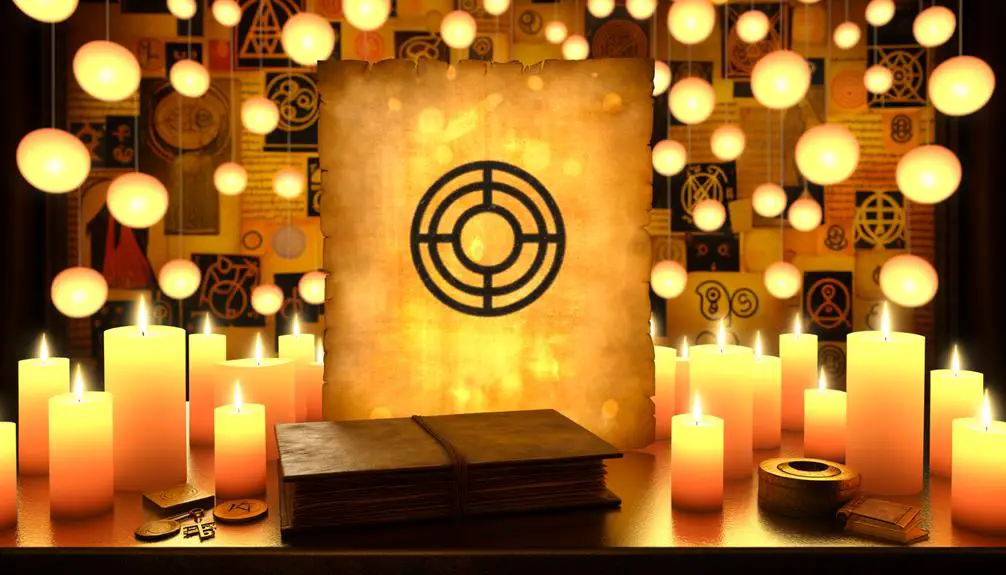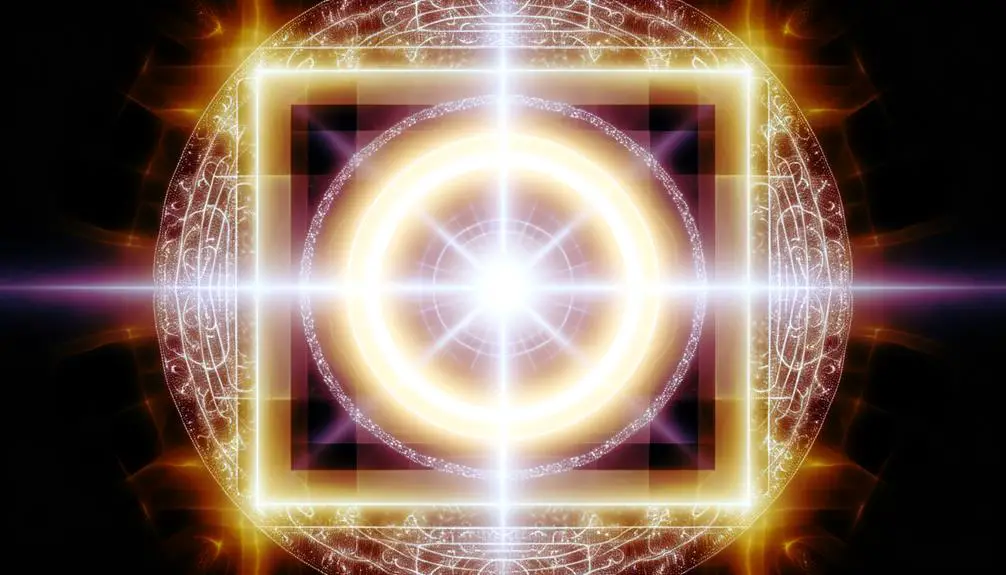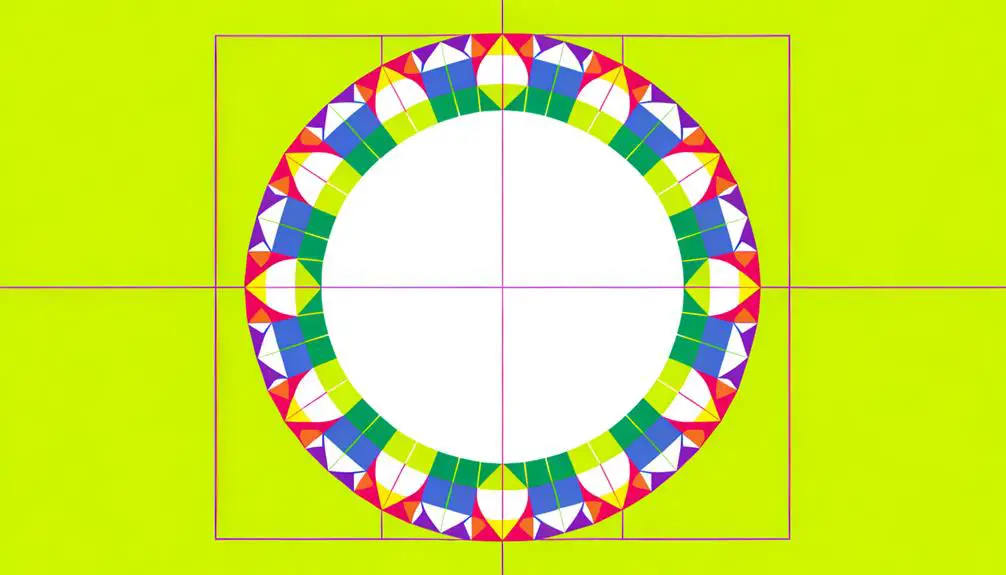What is the Spiritual Meaning of the Circle Square Symbol?
The symbol of a circle within a square captures a complex relationship between spiritual ideals and material reality. Historically, it has surfaced in various traditions from Chinese cosmology to Renaissance art, symbolizing the harmony between heaven (circle) and earth (square).
It embodies unity, wholeness, and the integration of opposites, resonating through mystical, philosophical, and geometric principles. Artists like Da Vinci and architectural forms in Islamic culture have explored its profound depths.
In modern contexts, it influences urban planning, corporate branding, and interior design, merging ancient wisdom with contemporary aesthetics. Exploring further will reveal its timeless significance across diverse applications.

Key Takeaways
- The symbol represents harmony between heaven (circle) and earth (square), reflecting spiritual balance and unity.
- It has historical significance in cultures such as Chinese cosmology, Hindu mandalas, and medieval alchemy.
- The motif signifies the integration of opposites and a quest for holistic balance.
- Artists like Leonardo da Vinci have explored its depth, depicting cosmic unity and sacred geometry.
- Modern applications include urban planning, corporate branding, and interior design, emphasizing harmony and inclusivity.
Historical Significance

The symbol of a circle within a square has held profound significance across various cultures and historical periods, often embodying the interplay between the eternal and the temporal.
In ancient Chinese cosmology, this motif represented the harmony between heaven (circle) and earth (square).
Similarly, in Renaissance architecture, the Vitruvian Man by Leonardo da Vinci encapsulated human proportion through this geometric synthesis, symbolizing an ideal balance.
Medieval alchemists used it to denote the philosopher's stone, illustrating the union of the spiritual and material worlds.
This archetypal symbol, deeply embedded in human consciousness, bridges abstract notions of infinity and the concrete domain, reflecting humanity's timeless quest for unity and understanding in the cosmic order.
Cultural Interpretations
Cultural interpretations of the circle in a square symbol reveal a tapestry of meanings across different societies, from ancient civilizations to the present day.
In historical contexts, this geometric motif has often embodied the union of heaven and earth, representing the interplay between the divine and the material.
Contemporary cultural relevance persists, as the symbol continues to be interpreted through various lenses, including spiritual harmony, holistic balance, and the integration of opposites in modern design and philosophy.
Ancient Symbolism Insights
In ancient cultures, the circle within a square symbol often represented the harmonious balance between the celestial and the earthly domains, embodying a profound synthesis of spiritual and earthly elements. This symbolism was deeply ingrained in various traditions, reflecting a unified cosmology.
Chinese Philosophy: The square symbolized Earth, while the circle represented Heaven, illustrating the union of terrestrial and divine forces.
Hindu Mandalas: The structure depicted the universe, with the outer square symbolizing the material world and the inner circle representing spiritual wholeness.
Alchemical Traditions: The symbol indicated the reconciliation of opposites, essential for achieving the philosopher's stone.
Native American Symbols: The circle within a square was seen as a representation of the four cardinal directions and the cyclical nature of life.
This ancient symbolism reveals an enduring quest for balance and unity.
Modern Cultural Relevance
Modern interpretations of the circle within a square symbol reveal its continued relevance in various cultural contexts, often serving as a metaphor for the interplay between modernity and tradition.
In contemporary architecture, this symbol is frequently utilized to signify the harmonious integration of innovative design within the framework of historical preservation.
In digital interfaces, it embodies the seamless blending of user-centric experiences with structured, grid-based layouts.
Additionally, in psychological and philosophical discourses, it represents the balance between an individual's inner self (the circle) and external societal structures (the square).
These modern uses underscore the symbol's enduring significance, illustrating how ancient motifs can be repurposed to convey complex ideas in today's diverse sociocultural landscapes.
Spiritual Symbolism

In spiritual contexts, the circle in a square symbolizes the integration of unity and wholeness, represented by the circle, with the structured balance and harmony of the square.
Historically, this imagery has been prevalent in various mystical traditions, such as alchemy and sacred geometry, where it signifies the reconciliation of opposites and the attainment of spiritual completeness.
This synthesis underscores the human quest for inner equilibrium and the harmonious coexistence of diverse elements within the self.
Unity and Wholeness
Often seen in various spiritual traditions, the circle within a square symbol represents the confluence of unity and wholeness, encapsulating the essence of the infinite and the finite.
Historically, the circle has been a universal symbol of eternity, cycles, and the divine, while the square signifies the material world, stability, and order. The integration of these shapes conveys profound spiritual insights:
- Cosmic Unity: Merging the infinite circle with the finite square symbolizes the interconnectedness of all existence.
- Sacred Geometry: This combination is foundational in many spiritual teachings, representing holistic balance.
- Philosophical Completeness: It embodies the unity of mind, body, and spirit.
- Cultural Universality: Found in diverse cultures, it underscores a shared spiritual understanding.
This symbol's rich historical context invites deep reflection on unity and wholeness.
Balance and Harmony
Building on the profound spiritual insights of unity and wholeness, the circle within a square also symbolizes a delicate equilibrium, where balance and harmony are paramount to understanding its deeper spiritual significance.
Historically, this geometric interplay has been revered in ancient cultures, such as in Taoist philosophy, where it represents the harmonization of yin and yang. The circle, symbolizing the infinite and the divine, contrasts with the square, representing the earthly and the material. This union suggests a state of perfect balance, where spiritual and physical domains coexist harmoniously.
Interpretively, it encourages individuals to seek inner peace by aligning their spiritual aspirations with their earthly existence, fostering a holistic sense of well-being and interconnectedness.
Artistic Representations
Throughout history, artistic representations of the circle within a square have surfaced in diverse cultures, symbolizing a profound intersection of geometry, spirituality, and aesthetics. These motifs, found in architectural design, religious iconography, and visual arts, convey multifaceted meanings.
For instance:
- Ancient Mandalas: In Hindu and Buddhist traditions, mandalas often incorporate a circle within a square, representing the universe's structure.
- Renaissance Art: Artists like Leonardo da Vinci explored this symbol through Vitruvian Man, emphasizing human proportion and cosmic order.
- Islamic Architecture: Intricate tilework and mosaics often use this pattern to reflect divine infinity.
- Modern Art: Abstract artists, including Wassily Kandinsky, utilized this form to explore spiritual depth and compositional balance.
These representations underscore a timeless quest to understand the universe's harmony.
Geometric Harmony

The intricate interplay of circles and squares in various artistic representations underscores a deeper philosophical and mystical inquiry into geometric harmony. The unification of these shapes symbolizes the convergence of earthly and celestial domains. Historically, ancient cultures such as the Egyptians and Greeks revered geometry as a divine language, embodying cosmic truths.
The circle, often linked to infinity and the heavens, contrasts with the square, representing stability and the material world. Their intersection invites contemplation of balance and unity, reflecting principles found in sacred architecture and mandalas. This synthesis embodies a quest for equilibrium, resonating through mythologies and esoteric traditions.
The geometric harmony of a circle within a square transcends mere aesthetics, offering profound metaphysical insights.
Modern Applications
In contemporary design and architecture, the motif of a circle within a square has been harnessed to evoke themes of balance, unity, and transcendence, echoing its historical and philosophical significance. This timeless symbol is applied in various modern contexts to convey deeper meanings:
- Urban Planning: Central plazas often feature circular designs within square boundaries to symbolize community and inclusivity.
- Corporate Logos: Companies employ this motif to represent stability and innovation simultaneously.
- Interior Design: The interplay of circular and square elements in spaces fosters a sense of harmony and aesthetic appeal.
- Technological Interfaces: User interfaces incorporate these shapes to create intuitive and balanced designs.
These applications are not just decorative but serve to resonate with historical ideals of geometric and philosophical harmony.
Conclusion
The circle in a square symbol, enriched by its historical significance, cultural interpretations, spiritual symbolism, artistic representations, geometric harmony, and modern applications, serves as a multifaceted emblem.
Similar to an ancient tapestry woven with threads of diverse meanings, this symbol encapsulates the unity of opposites and the convergence of chaos and order.
Its enduring relevance underscores the human quest for understanding and balance, bridging temporal and spatial divides through its profound, universal resonance.






